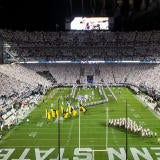
Sean Frazier is an idea guy. A former Alabama walk-on, the Northern Illinois athletic director is working overtime trying to find a place for marginalized schools like his to matter.
"There has to be somewhere for those teams to pursue their dreams," Frazier said.
While the College Football Playoff will expand to 12 teams beginning next season -- theoretically providing more access to Group of Five programs via automatic qualifiers for the five highest-ranked conference champions -- it's not enough access for some.
It has dawned on more folks than Frazier this week that the Big Ten is basically guaranteed the ability to celebrate a 2023 national champion. As the Pac-12 withers and dies, Washington is less than six months away from joining the conference. Michigan, a charter member of the 127-year-old league, currently rules the Big Ten.
The nation's oldest conference can't lose Monday night.
It is becoming increasingly apparent that -- even with the expanded 12-team playoff -- access will remain an issue for pretty much any school not in the Big Ten or SEC.
CBS Sports ran the numbers. Conference realignment and consolidation will make Monday's result -- a conference being guaranteed a national championship before the ball is kicked -- more frequent. Using 2024 conference affiliations, one league would have been guaranteed a title prior to the CFP National Championship four times in the 10-year existence of the CFP.
- 2014: Oregon vs. Ohio State (Big Ten)
- 2017: Georgia vs. Alabama (SEC)
- 2021: Alabama vs. Georgia (SEC)
- 2023: Michigan vs. Washington (Big Ten)
Expect it to happen more often. With 34 of the biggest, best brands now further combined in the Big Ten and SEC, those two conferences are almost certainly going to account for a majority of playoff berths going forward.
Since the CFP started in 2014, 72.5% of playoff participants (29 of 40) would have represented the Big Ten and SEC based on the leagues' 2024 configurations. If the expanded playoff been in place this season with conferences already in their 2024 alignments, 10 of 12 participants would have come from Big Ten and SEC -- five from each conference.
Most telling: Teams that will be part of the Big Ten and SEC in 2024 would have combined to average 7.6 of 12 spots if the expanded playoff had been in place over the last 10 seasons. This despite the 34 combined teams in those conferences making up just 25.6% of FBS competitors.
The remaining average of 4.4 playoff spots per season would be divvied up among the remaining 99 FBS programs.
At least for the next two seasons, one of those spots is guaranteed to the highest-ranked Group of Five champion. This season, the only 12-team playoff bids taken by teams other than those in the Big Ten and SEC would have gone to Florida State and Liberty.
"That scares me," said Frazier, now entering his 12th year at NIU.
That's where his idea takes shape. For those marginalized teams, he is proposing a sort-of college football NIT -- a tournament featuring the best of the rest, including schools in both the Power Four and Group of Five. The details are sketchy, but Frazier sees it as a way to keep the bowls from becoming what they have resembled at times this postseason: a series of hastily arranged spring games amid opt outs for NFL Draft preparation and the transfer portal.
A chance to pay players and to play for something, Frazier contends, would keep them around. It has long been speculated that bowls could eventually compensate players for their participation. Frazier has taken it a step further with an entire playoff based on that premise. The CFP has yet to address that possibility.
"You're always going to have significant bowl games left out of the CFP," Frazier said. "What I'm proposing is, let's look at the P5 and G5 institutions and their bowls and their tie ins. Let's put them in [their own playoff]."
Frazier is talking six-figure deals but doesn't quite know from where the money will come. But there is a history to his concept. Frazier's sense of desperation has only increased since 2017 when he proposed a Group of Five playoff that he priced at $160 million in rights fees. The Group of Five conferences (American, Conference USA, MAC, Mountain West, Sun Belt) currently split $103 million annually in CFP revenue.
UCLA coach Chip Kelly made news in December when he suggested the sport's leadership had failed it. He proposed a new division, basically made up of the 68 teams now in the Power Four. (ACC, Big Ten, Big 12, SEC plus Notre Dame).
"The game is better [with my proposal]," Kelly told CBS Sports. "And the closer and more competitive the games are, the better they are for television eyeballs. The better they are for television eyeballs, the better they are for advertisers."
All of it might be a subtle warning: Don't expect the new 12-team bracket to necessarily open the doors to the little guys.
Frazier idea is a bracketed playoff just like the CFP. With NCAA president Charlie Baker's proposal for a new subdivision, further marginalization of the have-nots might be ahead.
Look at what has happened to Oregon State and Washington State. California, Stanford and SMU went to extraordinary measures to continue playing major-college football across the country in the ACC.
"I think there will be a lot of conversation on alternatives," said Gator Bowl executive director Greg McGarity, who is not familiar with Frazier's plan. "The tried-and-true system now, it works, but again, there is so much emphasis put on the negative, the opt outs, the kids that don't want to play. It's a way to increase the value if those kids play in a game."
Frazier's Huskies snagged a part of major-bowl glory going 12-1 in the 2012 regular season before losing to Florida State in the Orange Bowl, a BCS game in 2013. Frazier has prided himself on trying to schedule Power Five opponents in the nonconference to stay in that BCS/New Year's Six conversation.
It got personal for numerous Group of Five ADs when Liberty got into the Fiesta Bowl despite a schedule strength ranked 109th by SportsSource Analytics, one of the metrics used by the CFP Selection Committee.
"Since I've been here, we knocked off Purdue, Nebraska, Georgia Tech," Frazier said. "We have a history of doing that. You're telling me that those are not going to be valued [by the committee]? Why the hell would I play them if I have an inside track playing Little Sisters of the Poor?"
Unlike that 2017 Group of Five playoff proposal, Frazier's new effort would include every school not chosen for the CFP.
"We've got some significant problems, and we've got to come up with solutions," Frazier said. "One of them is this NIT concept. At the very least, as this 12-team playoff comes through, you could have more opt outs [among those non-playoff teams]."
The expanded bracket has the potential to make the CFP the second-biggest sports event in the country next to the Super Bowl. A record media rights contract by 2026 is almost assured.
While the existence Cinderellas playing in first-round games potentially drag down the value of the that new CFP deal, industry experts expect $1.2 billion to $1.5 billion annually for the CFP rights. They are currently worth $600 million annually, minus the separate deal the Rose Bowl had with the Big Ten and Pac-12.
That's at least a 2X increase. That's also incredibly low, according to Redbird Capital CEO Jerry Cardinale. Speaking at a Sports Business Journal event last month, he said colleges are leaving money on the table with their product earning 10 times less than the NFL in media revenue.
Cardinale suggested conferences become engaged in a "unified rights-based media product."
"We should close the gap," he said.
That former Alabama walk-on has an idea.
















